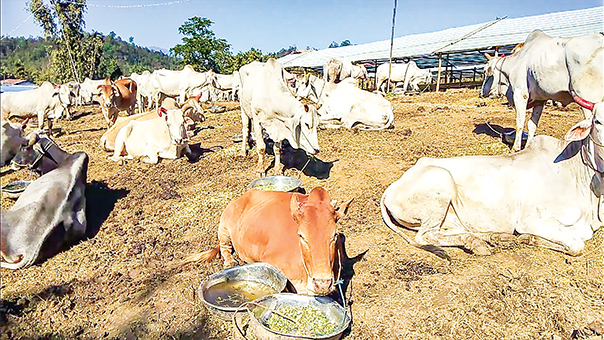With the Chinese New Year approaching, the live cattle export market at Muse has cooled, and about 3,000 heads of cattle have been stranded in the border area, causing difficulties to traders.
Traders usually transport 20-25 heads of cattle per 12-wheeled truck from Mandalay to Muse gate. The live cattle have to undergo an inspection at the 16th mile gate, Yebyu gate, and the animal disease surveillance station near Pakyu Village in Kutkai Township, to check whether they meet the export standard and a health certificate has been issued for them.
Prior to being exported, they are kept on the roadside in Kyinsankyawt and in farms rented in Muse Town.
Normally, a large cow is valued at over K1.8-2.2 million, but suspension of trade often leads to Chinese traders resorting to price manipulation and offering a lower price.
“We prefer a Government-to-Government agreement for live cattle trade as it can benefit both the traders and the two countries. While cattle exports are legal in Myanmar, livestock trade is still not permitted by China, leading to traders incurring debts. If there is a legitimate market for cattle export, we can get a good price and regular market. We are hoping for it to happen,” said traders from Kyaukse Township.
At present, cattle exports to China are on the decline owing to suspension of trade by China even though the Chinese New Year is approaching. As a result, traders have been burdened by labour wages, cost of feedstuff, healthcare services, and other general costs.
It costs K3,000-5,000 per day to feed one cow. For 100 heads of cattle, the cost totals about K400,000-500,000 per day. Corn, sugarcane, and straw are used as cattle feed.
Myanmar’s exports of animal products between 1 October and 3 January in the current financial year touched a low of US$47.13 million, a sharp drop of $131.38 million compared with the corresponding period of the 2018-2019FY, when livestock trade was suspended by China.
In the previous fiscal, animal products exports were registered at $178.28 million.
Animal products exports are mainly driven by the private sector, with income from the public sector amounting to less than $1 million.
Myanmar has held a series of negotiations with China at the Joint Border Trade Cooperation and Coordinating Committee (JBTCC) meetings on legal exports of cattle along with cross-border control of communicable diseases.
Myanmar, which allowed livestock trade in late 2017, is now exploring new export markets for cattle.
The country exports cattle that are above five years old along with vaccination certificates, health certificates, and farming registration certificates According to the 2018 cattle census, there are 11.5 million heads of cattle in the country.
Between the 2017-2018FY and the month of October in the current FY, more than 460,000 heads of cattle, worth over $581 million, have been exported to China through Muse, according to trade figures.
The authorities have issued cattle export licenses to more than 300 companies in Magway Region. There are around 5,000 companies holding cattle export licenses across the country. —Thant Zin/ Ko Htet
(Translated by Ei Myat Mon)



